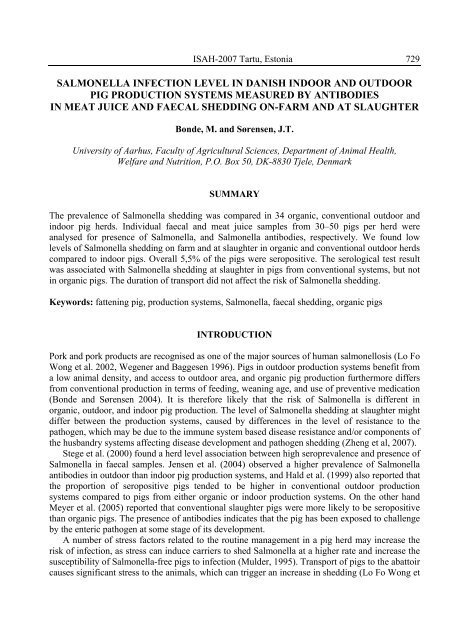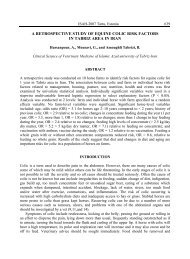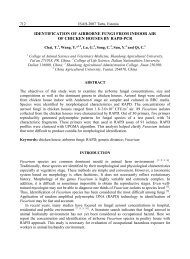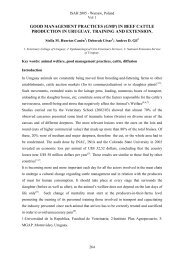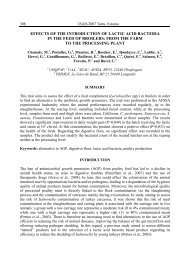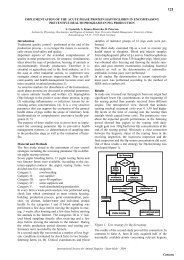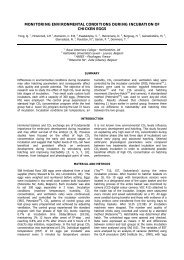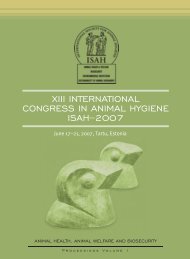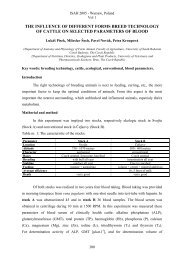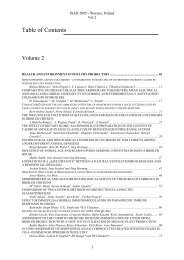salmonella infection level in danish indoor and outdoor ... - ISAH-SOC
salmonella infection level in danish indoor and outdoor ... - ISAH-SOC
salmonella infection level in danish indoor and outdoor ... - ISAH-SOC
Create successful ePaper yourself
Turn your PDF publications into a flip-book with our unique Google optimized e-Paper software.
<strong>ISAH</strong>-2007 Tartu, Estonia 731Information about duration of transport to slaughter was collected from 155 batches of pigs(50 organic, 58 conventional <strong>outdoor</strong>, <strong>and</strong> 47 <strong>in</strong>door batches).Qualitative bacteriological <strong>and</strong> serological data at pig <strong>level</strong> were analysed by log-l<strong>in</strong>earmodels (Us<strong>in</strong>g the SAS Proc GENMOD), tak<strong>in</strong>g herd <strong>and</strong> batch <strong>in</strong>to account. Serological testresponse, Salmonella shedd<strong>in</strong>g on-farm <strong>and</strong> Salmonella shedd<strong>in</strong>g at the abattoir were all assumedb<strong>in</strong>omial distributed with logit as the l<strong>in</strong>k function. The models were:1. Serological test response (positive/negative) = system (organic, conventional <strong>outdoor</strong>, <strong>in</strong>door)+ any cl<strong>in</strong>ical symptoms (yes/no)2. Salmonella shedd<strong>in</strong>g on-farm (positive/negative) = system (organic, conventional <strong>outdoor</strong>,<strong>in</strong>door) + serological test response (positive/negative) + any cl<strong>in</strong>ical symptoms (yes/no)3. Salmonella shedd<strong>in</strong>g at slaughter (positive/negative) = system (organic, conventional <strong>outdoor</strong>,<strong>in</strong>door) + serological test response (positive/negative) + Salmonella shedd<strong>in</strong>g on-farm(positive/negative) + duration of transport ( 3 hours) + system*serological test responseDifferences <strong>in</strong> transport duration between systems were analysed <strong>in</strong> SAS by Proc GLM, <strong>and</strong>differences <strong>in</strong> cl<strong>in</strong>ical symptoms between systems were analysed <strong>in</strong> SAS by Proc GENMOD.RESULTSThe prevalence of Salmonella <strong>in</strong> the different production systems is illustrated <strong>in</strong> Table 1. Overall5,5% of the pigs were seropositive with no significant differences between systems (P=0,11). Theoverall prevalence of Salmonella <strong>in</strong> faecal samples from pigs on-farm was 0,87%; the systemswere significantly different (P
732<strong>ISAH</strong>-2007 Tartu, EstoniaThe duration of transport is illustrated <strong>in</strong> Figure 2. The mean durations of transport toslaughter were 175,3 m<strong>in</strong> (organic pigs), 128,6 m<strong>in</strong> (conventional <strong>outdoor</strong> pigs) <strong>and</strong> 96,8 m<strong>in</strong>(<strong>in</strong>door pigs) (P
<strong>ISAH</strong>-2007 Tartu, Estonia 733systems test<strong>in</strong>g positive for antibodies aga<strong>in</strong>st Salmonella was not different from pigs reared <strong>in</strong><strong>in</strong>door production systems, while the proportion of antibody positive pigs tended to be higher <strong>in</strong>conventional <strong>outdoor</strong> production systems. On the other h<strong>and</strong>, Meyer et al. (2005) reported thatconventional slaughter pigs were significantly more likely to be seropositive than organic pigs.The prevalence of Salmonella shedd<strong>in</strong>g <strong>in</strong> pigs from <strong>outdoor</strong> systems was significantly lessthan <strong>in</strong> <strong>in</strong>door herds. Baggesen et al. (1996) found an overall prevalence of Salmonella shedd<strong>in</strong>gat slaughter of 6,2%, which is higher than the overall prevalence of 2,2% <strong>in</strong> this survey, <strong>and</strong> alsoof the prevalence for <strong>in</strong>door pigs: 4,0% <strong>in</strong> this survey. There is a ten-year difference between thetwo surveys, so the apparent difference probably is the effect of the current Salmonella controlprogramme <strong>in</strong> Denmark aim<strong>in</strong>g to m<strong>in</strong>imise the risk of Salmonella <strong>in</strong> slaughter pigs (Mous<strong>in</strong>g etal., 1997). The lack of association between Salmonella shedd<strong>in</strong>g <strong>and</strong> cl<strong>in</strong>ical symptoms is <strong>in</strong>agreement with Stege et al. (2000) report<strong>in</strong>g predom<strong>in</strong>antly subcl<strong>in</strong>ical salmonellosis <strong>in</strong> Danishf<strong>in</strong>ish<strong>in</strong>g pigs. The low <strong>level</strong>s of Salmonella shedd<strong>in</strong>g <strong>in</strong> organic <strong>and</strong> <strong>outdoor</strong> pigs suggest thatpigs from low <strong>in</strong>put systems may be more resistant to the pathogen, or may encounter the<strong><strong>in</strong>fection</strong> earlier <strong>in</strong> life so they have cleaned themselves from <strong><strong>in</strong>fection</strong> at time of slaughter. Thepoor association between seropositivity <strong>and</strong> shedd<strong>in</strong>g of Salmonella <strong>in</strong> organic pigs at slaughter<strong>in</strong>dicates that a serological test might be better suited to conventional than organic herds as ameans to identify <strong>in</strong>dividual pigs more likely to shed Salmonella.The differences <strong>in</strong> transport duration recognised <strong>in</strong> this survey did not affect the risk ofSalmonella shedd<strong>in</strong>g at slaughter. The transport distances <strong>in</strong> general were rather small, <strong>and</strong> it islikely that a notable effect of transport relies on more substantial differences <strong>in</strong> transport time.ACKNOWLEDGEMENTSThe authors gratefully acknowledge from the European Community f<strong>in</strong>ancial participation underthe Sixth Framework Programme for Research, Technological Development <strong>and</strong> DemonstrationActivities, for the Integrated Project QUALITYLOWINPUTFOOD, FP6-FOOD-CT-2003-506358. We are grateful to the participat<strong>in</strong>g farmers <strong>and</strong> the research technicians Orla Nielsen,Henrik Krogh Andersen, Krist<strong>in</strong>e Riis Hansen <strong>and</strong> Michael Hansen for their assistance collect<strong>in</strong>gfaecal samples on-farm. Danish Crown gathered the transport data, collected the samples at theabattoirs, <strong>and</strong> analysed all bacteriological samples; the meat juice samples were analysed at theDanish Institute of Food <strong>and</strong> Veter<strong>in</strong>ary Research. Furthermore, serotyp<strong>in</strong>g of Salmonella isolatesfrom faecal <strong>and</strong> caecal samples were carried out at the Danish Institute of Food <strong>and</strong> Veter<strong>in</strong>aryResearch.DISCLAIMERThe views expressed <strong>in</strong> this publication are the sole responsibility of the authors <strong>and</strong> do notnecessarily reflect the views of the European Commission. Neither the European Commission norany person act<strong>in</strong>g on behalf of the Commission is responsible for the use, which might be made ofthe <strong>in</strong>formation conta<strong>in</strong>ed here<strong>in</strong>.
734<strong>ISAH</strong>-2007 Tartu, EstoniaREFERENCESBaggesen, D.L., Wegener, H.C., Bager, F., Stege, H., Christensen, J., 1996. Herd prevalence of Salmonellaenterica <strong><strong>in</strong>fection</strong>s <strong>in</strong> Danish slaughter pigs determ<strong>in</strong>ed by microbiological test<strong>in</strong>g. Preventive Veter<strong>in</strong>aryMedic<strong>in</strong>e 26: 201–213.Bonde, M., Sørensen, J.T., 2004. Herd health management <strong>in</strong> organic pig production us<strong>in</strong>g a qualityassurance system based on Hazard Analysis <strong>and</strong> Critical Control Po<strong>in</strong>ts. NJAS-Wagen<strong>in</strong>gen Journal ofLife Sciences 52: 133–143.Hald, T., Lo Fo Wong, D.M.A., W<strong>in</strong>gstr<strong>and</strong>, A., 1999. Zoonotisk Salmonella i alternativ husdyrproduktion(In Danish). In: Proceed<strong>in</strong>gs from the Annual Meet<strong>in</strong>g of the Danish Veter<strong>in</strong>ary Association 1999,section for cl<strong>in</strong>ical microbiology, 5 pp. Danish Veter<strong>in</strong>ary Association: Copenhagen, Denmark.Jensen, A.N., Lodal, J., Baggesen, D.L., 2004. High diversity of Salmonella serotypes found <strong>in</strong> anexperiment with <strong>outdoor</strong> pigs. NJAS-Wagen<strong>in</strong>gen Journal of Life Sciences 52: 109–117.Ledergerber, U., Regula, G., Danuser, J., Bissig-Choisat, B., Jemmi, T., Stark, K.D.C., 2003. Prevalence oflatent zoonoses <strong>in</strong> pigs <strong>and</strong> pork from animal-friendly farms. Archiv Für Lebensmittelhygiene 54: 90–94.Lo Fo Wong, D.M.A., Hald, T., van der Wolf, P.J., Swanenburg, M., 2002. Epidemiology <strong>and</strong> controlmeasures for Salmonella <strong>in</strong> pigs <strong>and</strong> pork. Livestock Production Science 76: 215–222.Meyer, C., Beilage, E.G., Krieter, J., 2005. Salmonella seroprevalence <strong>in</strong> different pig production systems.Tieraerztliche Praxis Ausgabe Grosstiere Nutztiere 33: 104–112.Morgan, J.R., Krautil, F.L., Craven, J.A., 1987. Effect of time <strong>in</strong> lairage on caecal <strong>and</strong> carcass Salmonellacontam<strong>in</strong>ation of slaughter pigs. Epidemiol. Infect. 98: 323–330.Mous<strong>in</strong>g, J., Jensen, P.T., Halgaard, C., Bager, F., Feld, N., Nielsen, B., Nielsen, J.P., Bech-Nielsen, S.,1997. Nation-wide Salmonella enterica surveillance <strong>and</strong> control <strong>in</strong> Danish slaughter sw<strong>in</strong>e herds. Prev.Vet. Med. 29, 247–261.Mulder, R.W.A.W., 1995. Impact of transport <strong>and</strong> related stresses on the <strong>in</strong>cidence <strong>and</strong> extent of humanpathogens <strong>in</strong> pig meat <strong>and</strong> poultry. J. Food Safety 15: 239–246.Nielsen, B., Ekeroth, L., Bager, F., L<strong>in</strong>d, P., 1998. Use of muscle fluid as a source of antibodies for serologicdetection of Salmonella <strong><strong>in</strong>fection</strong> <strong>in</strong> slaughter pig herds. J. Vet. Diagn. Invest. 10: 158–163.Stege, H., Christensen, J., Nielsen, J.P., Baggesen, D.L., Enøe, C., Willeberg, P., 2000. Prevalence ofsubcl<strong>in</strong>ical Salmonella enterica <strong><strong>in</strong>fection</strong> <strong>in</strong> Danish f<strong>in</strong>ish<strong>in</strong>g pig herds. Preventive Veter<strong>in</strong>ary Medic<strong>in</strong>e44: 175–188.Wegener, H.C., Baggesen, D.L., 1996. Investigation of an outbreak of human salmonellosis caused bySalmonella enterica serovar <strong>in</strong>fantis by use of pulsed field gel electrophoresis. International Journal ofFood Microbiology 32: 125–131.Zheng, D.M., Bonde M., Sørensen J.T., 2007. Associations between the proportion of Salmonellaseropositive slaughter pigs <strong>and</strong> the presence of herd <strong>level</strong> risk factors for <strong>in</strong>troduction <strong>and</strong> transmissionof Salmonella <strong>in</strong> 34 Danish organic, <strong>outdoor</strong> (non-organic) <strong>and</strong> <strong>in</strong>door f<strong>in</strong>ish<strong>in</strong>g-pig farms. LivestockScience 106: 189–199.


